Clean Label Ingredients Market by Ingredient Type (Natural Flavors, Natural Colors, Fruit & Vegetable Ingredients, Starch & Sweeteners, Flours, Malt), Application (Food, Beverages), Form (Dry, Liquid), Certification Type - Global Forecast to 2029
[181 Pages Report] The global clean label ingredients market is on a trajectory of significant expansion, with an estimated value projected to reach USD 69.3 billion by 2029 from the 2024 valuation of USD 50.2 billion, displaying a promising Compound Annual Growth Rate (CAGR) of 6.7%. The demand for clean label ingredient demand is rising sharply due to a confluence of factors that span consumer preferences, regulatory pressures, and advancements in food technology. This trend is significantly transforming the landscape of food production and marketing, driven by an increasingly health-conscious and informed consumer base.
Consumers are becoming more educated about the potential health risks associated with artificial additives, preservatives, and genetically modified organisms (GMOs). This increased awareness is propelling them to seek out products that contain natural, minimally processed ingredients. For instance, according to a 2021 survey by the International Food Information Council (IFIC), 63% of consumers are paying more attention to ingredient lists. The desire for transparency in food labelling has led companies to adopt clean label practices, ensuring their products meet consumer expectations for simplicity and wholesomeness.
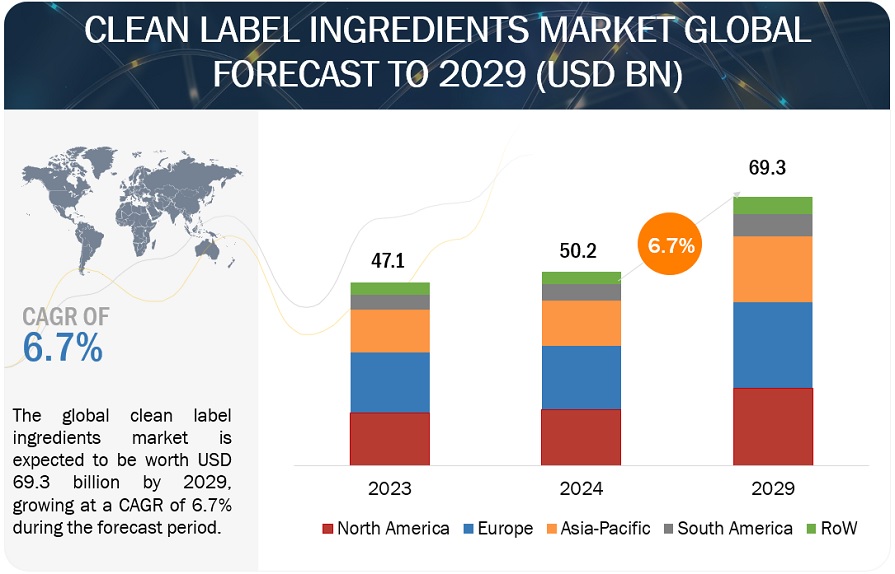
To know about the assumptions considered for the study, Request for Free Sample Report
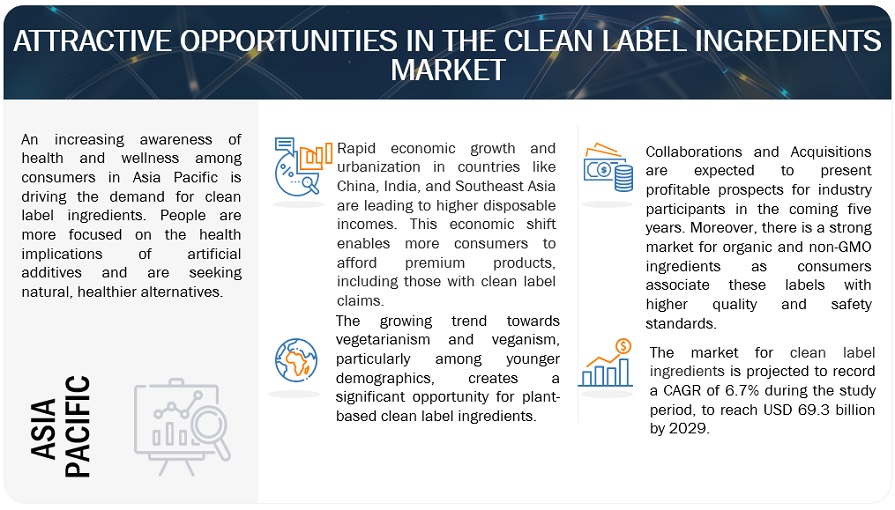
To know about the assumptions considered for the study, download the pdf brochure
Market Dynamics
Drivers: Rise in clean label product launches fueled by consumer demand
The clean label ingredients market is driven primarily by evolving consumer preferences for healthier and more transparent food options. As people become increasingly health-conscious and concerned about the ingredients in their food, there has been a surge in the demand for products with clean labels. These labels typically signify that the product is made with simple, recognizable ingredients, free from artificial additives, preservatives, and other undesirable substances.
Consumers are actively seeking out products that align with their values of health, sustainability, and transparency. They are scrutinizing ingredient lists more closely, preferring natural and minimally processed options over synthetic alternatives. This growing demand for clean label products has prompted food manufacturers to respond by reformulating their products or launching new offerings that meet these criteria. For instance, in March 2023, Ingredion (US) introduced a new range of texturizers to its US portfolio of clean label ingredient solutions. These innovative texturizers, known as Fibertex CF citrus fibers, are derived from the peels of citrus fruits such as lemons and limes. By harnessing the natural properties of citrus peels, Ingredion aims to assist manufacturers in addressing clean label challenges while meeting evolving consumer preferences.
Restraints: Limitations/inability of clean ingredients to replace artificial ingredients
While the demand for clean label products is on the rise, manufacturers often encounter challenges when attempting to replace artificial ingredients with their natural counterparts. One significant restraint lies in the functionality and versatility of clean label ingredients compared to their synthetic equivalents. Artificial ingredients are often chosen for their ability to enhance flavor, texture, shelf-life, and other desirable characteristics of food products. However, finding suitable natural alternatives that can replicate these functionalities without compromising on quality can be a complex and costly endeavor. Clean label ingredients may not always offer the same level of performance or stability, leading to potential issues such as flavor inconsistencies, shorter shelf-life, or altered texture.
Moreover, some natural ingredients may be limited in availability or subject to seasonal fluctuations, making them less reliable for large-scale production compared to synthetic alternatives that can be manufactured consistently year-round. These inherent limitations pose a significant restraint for manufacturers looking to transition to cleaner formulations while maintaining product quality and consistency.
Opportunities: Development of natural ingredients with functional benefits
Nowadays, consumers are not only seeking products with clean labels but also demanding added health benefits and functional properties. This presents a promising opportunity for ingredient suppliers and manufacturers to collaborate in the creation of natural ingredients that not only meet clean label criteria but also offer enhanced nutritional value and functional advantages. For instance, there is increasing interest in ingredients such as plant-based, fiber-rich additives, and natural ingredients that can contribute to improved health outcomes and cater to specific dietary preferences.
The convergence of food science and technology has enabled the development of novel extraction and processing techniques that preserve the nutritional integrity of natural ingredients while unlocking their full functional potential. From enhancing texture and stability to fortifying products with vitamins and minerals, the possibilities for innovation in clean label ingredient development are vast.
By capitalizing on these opportunities, companies can differentiate their products in the market, appeal to health-conscious consumers, and stay ahead of evolving regulatory requirements. The development of natural ingredients with functional benefits not only aligns with consumer preferences but also contributes to the overall advancement of the clean label ingredients market.
Challenges: False or deceptive labeling claims by manufacturers
As consumer demand for clean label products continues to soar, there is a growing risk of greenwashing – the practice of misleading consumers into believing that a product is more environmentally friendly or natural than it actually is. In an effort to capitalize on the clean label trend, some companies may engage in misleading marketing tactics, exaggerating the naturalness or healthfulness of their products without sufficient evidence to support such claims. This can erode consumer trust and undermine the credibility of the entire clean label ingredients market. Regulatory bodies are increasingly scrutinizing product labeling and marketing practices to combat deceptive claims and ensure transparency and accuracy in food labeling.
Market Ecosystem
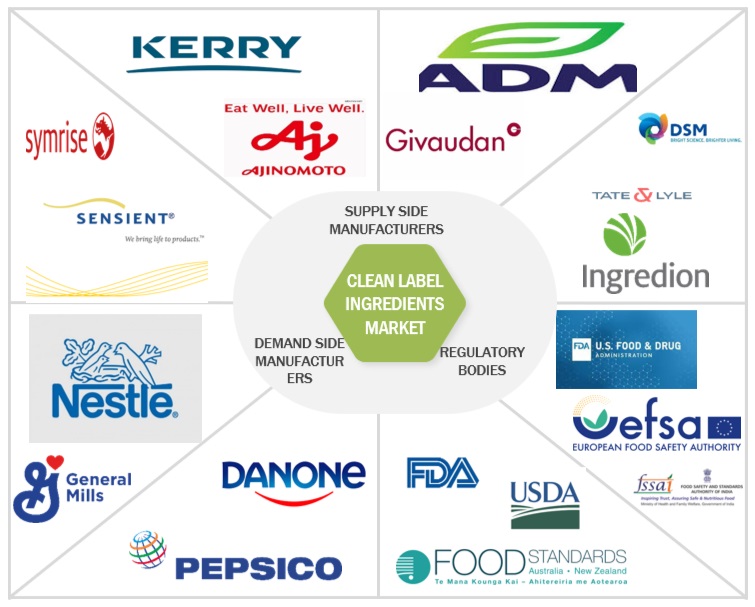
Dry Form Accounted For A Higher Market Share Among Form Segment In 2023.
The convenience factor plays a crucial role. Powdered or dry products offer ease of storage, transportation, and handling compared to other forms like liquid or solid. For instance, dry supplements and food additives are lightweight and compact, making them convenient for both manufacturers and consumers. This convenience translates into cost savings throughout the supply chain, from production to distribution.
Moreover, the versatility of dry form allows for a wide range of applications across industries. Brands can cater to diverse consumer preferences by offering a variety of formulations in dry form, enhancing their market appeal.
In September 2020, the Symrise (India) Division Diana Food introduced its first-ever clean label, organic, and Fair Trade-certified acerola powder. This marks a significant milestone, positioning Diana Food as an industry leader in catering to consumers seeking natural and health-focused solutions. Moreover, the versatility of the acerola powder opens up opportunities across various product categories, from nutritional supplements to functional foods and beverages. Its clean label and organic attributes cater to consumers seeking products with minimal additives and synthetic ingredients, further enhancing its market potential.
Asia Pacific is The Fastest-Growing Market for Clean Label Ingredients Among the Regions.
Asia Pacific is emerging as the fastest-growing market for clean label ingredients, driven by one of the primary drivers, which is the region's rapidly expanding middle class, which is increasingly health-conscious and willing to spend on premium food products. This demographic shift is accompanied by a rising awareness of food safety and nutrition, prompting consumers to seek products with natural and easily recognizable ingredients.
Local food manufacturers in the Asia Pacific are responding to this demand by innovating and reformulating products to include fewer artificial additives and more natural ingredients. This shift is supported by advancements in food technology, which facilitate the development of clean label alternatives that do not compromise on taste or quality. Moreover, the agricultural abundance in many Asia Pacific countries provides a rich source of natural ingredients, enabling the production of a diverse range of clean label products.
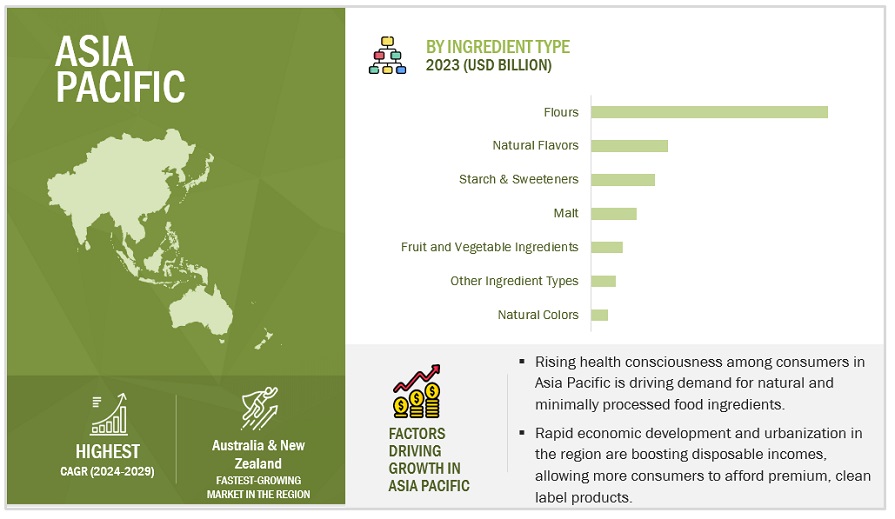
Key Market Players
The key players in this market include Cargill, Incorporated (US), ADM (US), DSM (Netherlands), International Flavors & Fragrances Inc. (US), Kerry Group plc (Ireland), BASF SE (Germany), Ingredion (US), Sensient Technologies Corporation (US), Corbion (Netherlands), Symrise (Germany), Chr. Hansen A/S (Denmark), Puratos (Belgium), Ajinomoto Co., Inc. (Japan), Tate & Lyle (UK), and Givaudan (Switzerland)
Get online access to the report on the World's First Market Intelligence Cloud
- Easy to Download Historical Data & Forecast Numbers
- Company Analysis Dashboard for high growth potential opportunities
- Research Analyst Access for customization & queries
- Competitor Analysis with Interactive dashboard
- Latest News, Updates & Trend analysis
Request Sample Scope of the Report
:
Get online access to the report on the World's First Market Intelligence Cloud
- Easy to Download Historical Data & Forecast Numbers
- Company Analysis Dashboard for high growth potential opportunities
- Research Analyst Access for customization & queries
- Competitor Analysis with Interactive dashboard
- Latest News, Updates & Trend analysis
|
Report Metric |
Details |
|
Market size estimation |
2024–2029 |
|
Base year considered |
2023 |
|
Forecast period considered |
2024–2029 |
|
Units considered |
Value (USD), Volume (KT) |
|
Segments Covered |
By Ingredient Type, Form, Application, Certification Type (Qualitative), and Region |
|
Regions covered |
North America, Europe, Asia Pacific, South America, and RoW |
|
Companies studied |
|
This research report categorizes the clean label ingredients market, based on ingredient type, form, application, certification type, and region.
Target Audience
- Clean Label Ingredients Manufacturers
- Food & Beverage Producers
- Food Processing Manufacturers
- Government Agencies (related to food safety and regulations such as FDA, EFSA, and FSSAI)
Clean Label Ingredients Market:
By Ingredient type
- Natural Colors
- Natural Flavors
- Fruit & Vegetable Ingredients
- Starch & Sweeteners
- Flours
- Malt
- Other Ingredient Types
By Form
- Dry
- Liquid
By Certification Type
- Organic
- Non-GMO
- Gluten-free
- Vegan
By Application
-
Food
- Dairy & Frozen Desserts
- Bakery Products
- Prepared Meals/Ready Meals
- Cereals & Snacks
- Meat, Poultry, & Seafood
- Other Food Applications
- Beverages
By Region
- North America
- Europe
- Asia Pacific
- South America
- Rest of the World (RoW)
Recent Developments
- In December 2022, DSM introduced two innovative canola-based ingredients under its new Vertis plant protein line: CanolaPro and Textured Pea Canola Protein. These proteins are the first clean-label options to include all nine essential amino acids. CanolaPro is a protein isolate derived from canola seeds, while the Textured Pea Canola Protein blends CanolaPro with pea protein. This recent development significantly contributes to the expansion of the clean label ingredients market, meeting the demand for transparent and natural food ingredients.
- In June 2021, BASF SE introduced Spongolit Pure 10, a clean-label premium aerating agent designed to enhance the volume and texture of cakes. This recent development supports the growth of the clean label ingredients market by meeting the increasing demand for clean label food ingredients.
Frequently Asked Questions (FAQ):
What is the current size of the clean label ingredients market?
The clean label ingredients market is estimated at USD 50.2 billion in 2024 and is projected to reach USD 69.3 billion by 2029, at a CAGR of 6.7% from 2024 to 2029.
Which are the key players in the market, and how intense is the competition?
The key players in the clean label ingredients market include Cargill, Incorporated (US), ADM (US), DSM (Netherlands), International Flavors & Fragrances Inc. (US), Kerry Group plc (Ireland), BASF SE (Germany), Ingredion (US), Sensient Technologies Corporation (US), Corbion (Netherlands), Symrise (Germany), Chr. Hansen A/S (Denmark), Puratos (Belgium), Ajinomoto Co., Inc. (Japan), Tate & Lyle (UK), and Givaudan (Switzerland).
The clean label ingredients market witnesses increased scope for growth. The market is seeing an increase in the number of joint ventures, acquisitions, and new expansions. Moreover, the companies involved in manufacturing clean label ingredients products are investing a considerable proportion of their revenues in research and development activities.
Which region is projected to account for the largest share of the clean label ingredients market?
The European market is expected to dominate during the forecast period. Europe’s dominance in the clean label ingredients market stems from a robust consumer awareness regarding health and wellness that has driven demand for clean label ingredients. This consumer behavior is supported by stringent regulatory standards that promote transparency and safety in food labeling. Additionally, the region has a robust agricultural sector and a history of innovation in food processing technologies, enabling the development and supply of high-quality natural ingredients. Moreover, European food manufacturers are proactive in adopting clean label practices to maintain competitive advantage and meet evolving consumer expectations.
What kind of information is provided in the company profile section?
The company profiles mentioned above offer valuable information such as a comprehensive business overview, including details on the company's various business segments, financial performance, geographical reach, revenue composition, and the breakdown of their business revenue. Additionally, these profiles offer insights into the company's product offerings, significant milestones, and expert analyst perspectives to further explain the company's potential.
What are the factors driving the clean label ingredients market?
The demand for clean label ingredients is surging globally due to evolving consumer demand for transparency and healthier food options is paramount, as more people seek products with simple, recognizable ingredients. Regulatory pressures and food safety standards also play a significant role, pushing manufacturers to adopt cleaner labels to comply with legal requirements. .
To speak to our analyst for a discussion on the above findings, click Speak to Analyst
The study involved two major segments in estimating the current size of the clean label ingredients market. Exhaustive secondary research was done to collect information on the market, peer, and parent markets. The next step was to validate these findings, assumptions, and sizing with industry experts across the value chain through primary research. Both top-down and bottom-up approaches were employed to estimate the complete market size. After that, market breakdown and data triangulation were used to estimate the market size of segments and subsegments.
Secondary Research
This research study involved the extensive use of secondary sources—directories and databases such as Bloomberg Businessweek and Factiva—to identify and collect information useful for a technical, market-oriented, and commercial study of the clean label ingredients market.
In the secondary research process, various sources such as annual reports, press releases & investor presentations of companies, white papers, food journals, certified publications, articles from recognized authors, directories, and databases, were referred to identify and collect information.
Secondary research was mainly used to obtain key information about the industry’s supply chain, the total pool of key players, and market classification and segmentation as per the industry trends to the bottom-most level, regional markets, and key developments from both market- and technology-oriented perspectives.
Primary Research
Extensive primary research was conducted after obtaining information regarding the clean label ingredients market scenario through secondary research. Several primary interviews were conducted with market experts from both the demand and supply sides across major countries of North America, Europe, Asia Pacific, South America, and the Rest of the World. Primary data was collected through questionnaires, emails, and telephonic interviews. The primary sources from the supply side included various industry experts, such as Chief X Officers (CXOs), Vice Presidents (VPs), Directors, from business development, marketing, research, and development teams, and related key executives from distributors, and key opinion leaders. Primary interviews were conducted to gather insights such as market statistics, data on revenue collected from the products, market breakdowns, market size estimations, market forecasting, and data triangulation. Primary research also helped in understanding the various trends related to clean label ingredients type, form, application, certification type, and region. Stakeholders from the demand side, such as food & beverage manufacturers who use the clean label ingredients were interviewed to understand the buyer’s perspective on the suppliers, products, and their current usage of clean label ingredients and the outlook of their business which will affect the overall market.
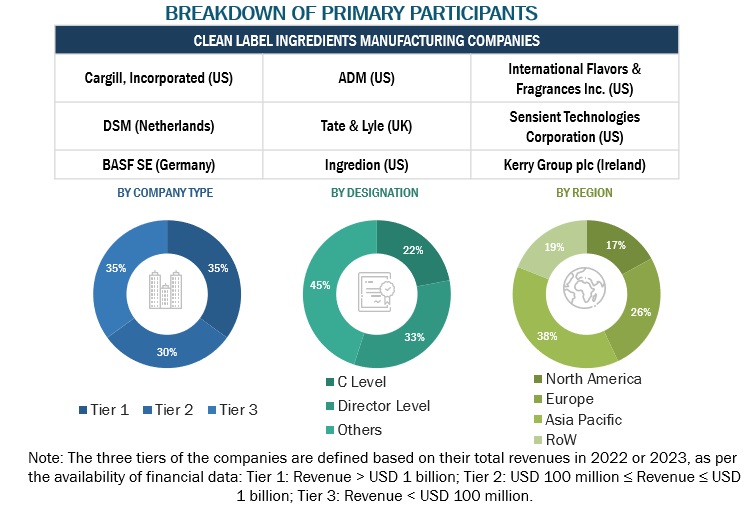
To know about the assumptions considered for the study, download the pdf brochure
|
COMPANY NAME |
DESIGNATION |
|
Cargill, Incorporated (US) |
Regional Sales Manager |
|
ADM (US) |
Marketing Manager |
|
International Flavors & Fragrances Inc. (US) |
General Manager |
|
DSM (Netherlands) |
Sales Manager |
|
Tate & Lyle (UK) |
Sales Manager |
|
Ingredion (US) |
Sales Executive |
Market Size Estimation
Both the top-down and bottom-up approaches were used to estimate and validate the total market size. These approaches were also used to estimate the size of various dependent submarkets. The research methodology used to estimate the market size includes the following:
- The key players in the industry and markets were identified through extensive secondary research.
- All shares, splits, and breakdowns were determined using secondary sources and verified through primary sources.
- All possible parameters that affect the markets covered in this research study were accounted for, viewed in extensive detail, verified through primary research, and analyzed to obtain the final quantitative and qualitative data.
- The research included the study of reports, reviews, and newsletters of top market players, along with extensive interviews for opinions from leaders, such as CEOs, directors, and marketing executives.
Global Clean Label Ingredients Market: Bottom-Up Approach.
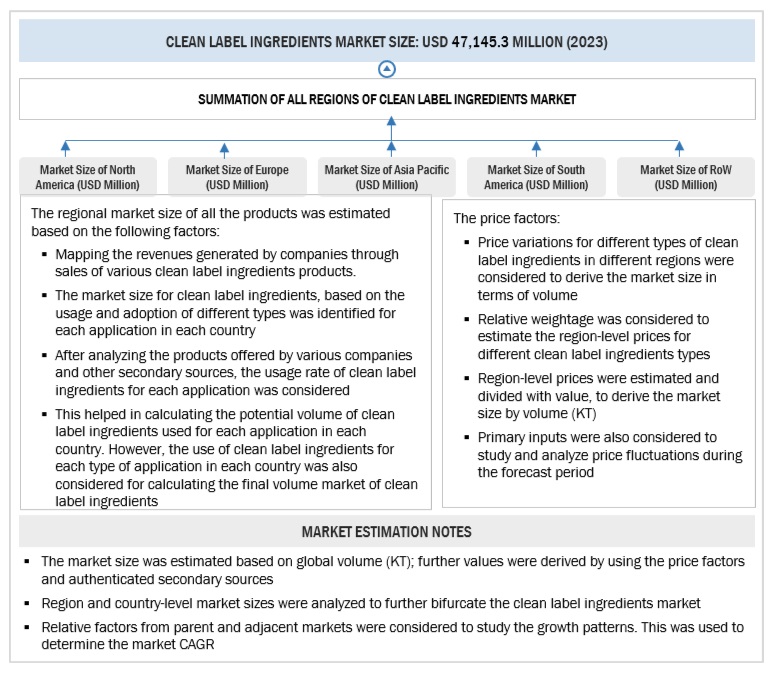
To know about the assumptions considered for the study, Request for Free Sample Report
Global Clean Label Ingredients Market: Top-Down Approach.
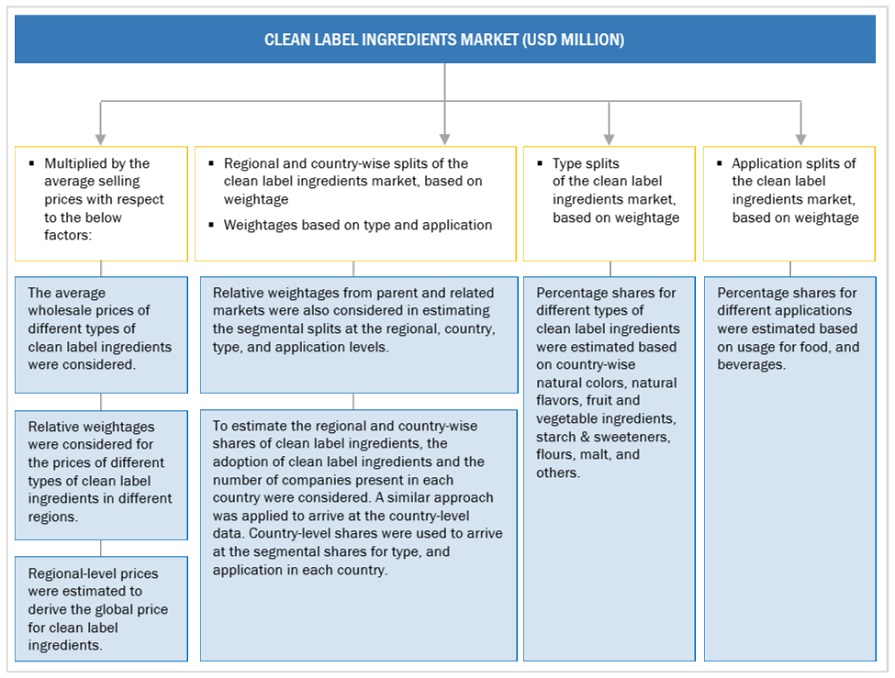
Data Triangulation
After arriving at the overall market size from the estimation process explained above, the total market was split into several segments and subsegments. To estimate the overall clean label ingredients market and arrive at the exact statistics for all segments and subsegments, data triangulation and market breakdown procedures were employed, wherever applicable. The data was triangulated by studying various factors and trends from the demand and supply sides. Along with this, the market size was validated using both the top-down and bottom-up approaches.
Market Definition
According to the Institute of Food Technologists, a Clean label means making a product using as few ingredients as possible and making sure those ingredients are items that consumers recognize and think of as wholesome—ingredients that consumers might use at home. It seeks out foods with easy-to-recognize ingredients and no artificial ingredients or synthetic chemicals, and it has become associated with “trust” with manufacturers of food.
Based on inferences drawn from multiple sources and taking into consideration the description of ‘clean label’ by stakeholders such as food ingredient manufacturers and consumers; ‘clean label’ ingredients are defined as food additives and ingredients such as colors, flavors, fruit & vegetable ingredients, starches & sweeteners, flours, malt, preservatives, fermentation ingredients, and others that comply with any or all of the primary factors, and at least one of the secondary factors mentioned below.
Primary factors:
- Fewer product ingredients with no chemical name and easy to understand
- No artificial additives or ingredients
Secondary factors:
- Natural
- Organic
- Non-GMO
Further, there is no standard regulatory definition for clean label ingredients. These are largely defined based on their meaning (clean label’s meaning) to end consumers.
Key Stakeholders
- Raw material suppliers
- Traders, distributors, and manufacturers & suppliers of clean label ingredients
- Food processors & food manufacturers
- Government and research organizations
- Trade associations and industry bodies
- Regulatory bodies such as Food & Drug Administration (FDA), European Commission, European Food Safety Authority (EFSA), and Food Standard Australia New Zealand (FSANZ)
-
Associations, regulatory bodies, and other industry-related bodies:
- European Communities
- World Health Organization (WHO)
- OECD-FAO Agricultural Outlook
- Organizations such as the Food and Drug Administration (FDA)
- United States Department of Agriculture (USDA)
- European Food Safety Agency (EFSA)
- Ministry of Food and Drug Safety (MFDS)
- China Food and Drug Administration (CFDA)
- Codex Alimentarius Commission
- Food Safety Australia and New Zealand (FSANZ)
- Intermediary suppliers such as traders, distributors, and suppliers of ingredients and end products
- End users
- Food & beverage manufacturers/suppliers
Report Objectives
- To define, segment, and forecast the global clean label ingredients market based on ingredient type, form, application, certification type, and region over a historical period ranging from 2019 to 2023 and a forecast period ranging from 2024 to 2029.
- To provide detailed information about the key factors influencing the growth of the market (drivers, restraints, opportunities, and challenges).
- Identifying attractive opportunities in the market by determining the largest and fastest-growing segments across the regions.
-
Analyzing the demand-side factors based on the following:
- Impact of macro and microeconomic factors on the market.
- Shifts in demand patterns across different subsegments and regions.
- To strategically profile the key players and comprehensively analyze their core competencies.
- To analyze competitive developments, such as partnerships, mergers & acquisitions, new product developments, and expansions & investments in the clean label ingredients market.
Available Customizations:
With the given market data, MarketsandMarkets offers customizations according to company-specific scientific needs.
The following customization options are available for the report:
Product Analysis
- Product Matrix, which gives a detailed comparison of the product portfolio of each company.
Geographic Analysis
With the given market data, MarketsandMarkets offers customizations according to company-specific scientific needs.
- Further breakdown of the Rest of the European clean label ingredients market into key countries
- Further breakdown of the Rest of Asia Pacific clean label ingredients market into key countries
- Further breakdown of the South American clean label ingredients market into key countries
Company Information
- Detailed analyses and profiling of additional market players (up to five)












Growth opportunities and latent adjacency in Clean Label Ingredients Market